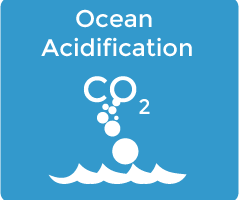The purpose of these preliminary experiments is for students to become familiar with carbon dioxide (CO2). In particular, these experiments aim to provide context for the role of carbon dioxide in global climate change and ocean acidification. Therefore, students should come away with an understanding of the natural and anthropogenic sources of CO2 as well as the interaction between carbon dioxide and water.
When teaching the topics of ocean acidification, climate change, environmental science, and sustainability, helping students learn to critically assess print and electronic articles, such as those found in newspapers, websites, magazines, journals, etc., is of utmost importance. In this lesson, each student in your class will read a different short news piece on various engaging and thought-provoking topics surrounding the changing carbon cycle.
The oceans cover 70 percent of the planet and play a critical role in regulating atmospheric carbon dioxide through the interaction of physical, chemical, and biological processes. As a result of anthropogenic activity, a doubling of the atmospheric CO2 concentration (to 760 ppm) is expected to occur by the end of this century.



